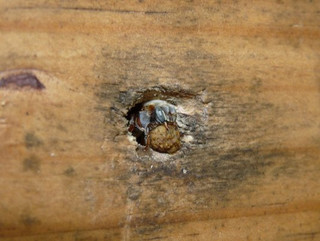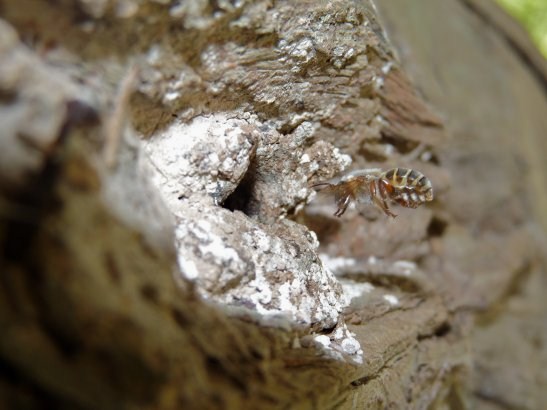
Habitat
Melipona
beecheii is part of the Melipona genus, which consists of
tropical stingless bees (Beismeijer 1999). M. beecheii in
particular is found from Mexico to Costa Rica (EOL 2013). It was
found that the temperatures in this range were found to be
between 16oC and 41oC and that the best operating temperature
for Melipona b. is between 16oC and 26oC (Beismeijer and Toth
1998). It also has been shown that the bee is more active in
higher humidity and high sunlight, which makes sense for the
geographic range (EOL 2013). The bees make their nests in nests
formerly made by termites or ants, trees and tree branches, and
also in the ground. (Beismeijer 1999) The bees cultivate nectar
from flowers, and produce honey. Much of the surviving colonies
are cultivated for honey by humans.
The
bees are well noted to be very selective, as shown in an
experiment run by Jacob Beismeijer and a team of researchers,
M.
Beecheii were shown to be more selective than even others from
the Melipona genus. (Beismeijer 1999). It is also noted by
those who cultivate the flowers. The cultivation of honey from
these bees is a sacred process for the Maya, and as said by one
cultivator of the bee, Don Porfírio, “It will, it seems, only
take nectar from the most beautiful flowers.” (Bellows 2012).
This is good for M. beecheii as they live sympatrically with
more than a dozen other stingless bee species (Beismeijer 1999).

Melipona
beecheii are very selective in their habitat location as well as
they will only reside in hollow logs that are over 30 cm wide.
Deforestation has therefor created a decline in the population.
Also, it has been shown that smaller organisms are more likely
to be affected by changes in temperature or rainfall or
sunlight, so abiotic factors could be attributed partially to
the rarity of M. beecheii. (EOL 2013) Melipona beecheii is
predated upon by birds, lizards and spiders as well which can
reduce the population of the species (Beismeijer and Toth 1998).
 Melipona beecheii is very susceptible to pesticides, and
because of that its numbers have been declining. The bee is also
hard to find in the wild, even in forested areas where
conditions are favorable (EOL 2013). Though Melipona beecheii
was first found in lowland forests, the bee has adapted to the
cycles of dry and wet seasons of other forests found around
their area.(EOL 2013) The introduction of the African and
European bees has lessened the ancient Mayan practice of
cultivating these bees, so their numbers in human captivity are
declining as well as in the wild (Beismeijer 1999). When being
cultivated by farmers, they are almost exclusively kept in logs.
(Villinueva-G 2005).
Melipona beecheii is very susceptible to pesticides, and
because of that its numbers have been declining. The bee is also
hard to find in the wild, even in forested areas where
conditions are favorable (EOL 2013). Though Melipona beecheii
was first found in lowland forests, the bee has adapted to the
cycles of dry and wet seasons of other forests found around
their area.(EOL 2013) The introduction of the African and
European bees has lessened the ancient Mayan practice of
cultivating these bees, so their numbers in human captivity are
declining as well as in the wild (Beismeijer 1999). When being
cultivated by farmers, they are almost exclusively kept in logs.
(Villinueva-G 2005).